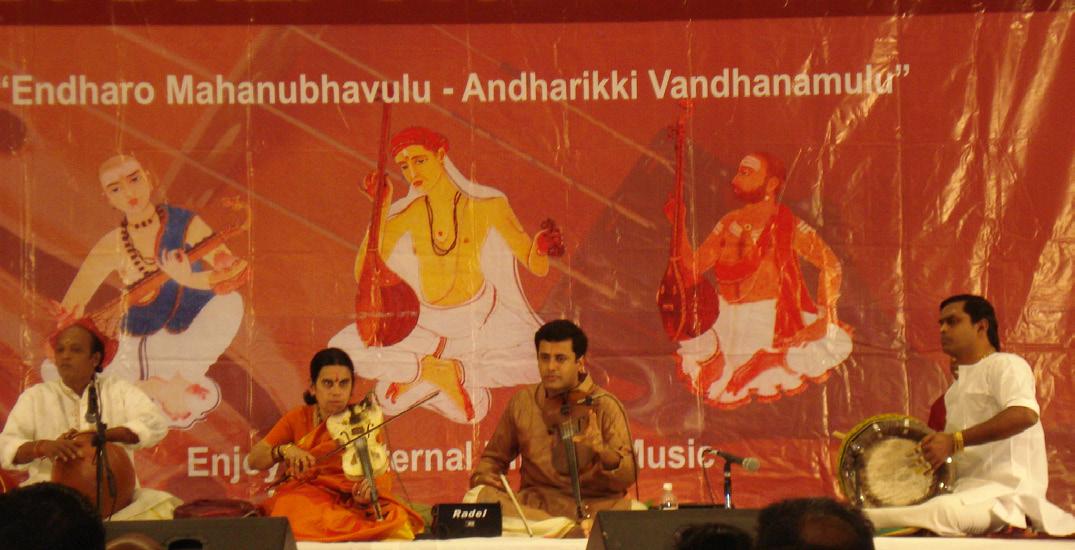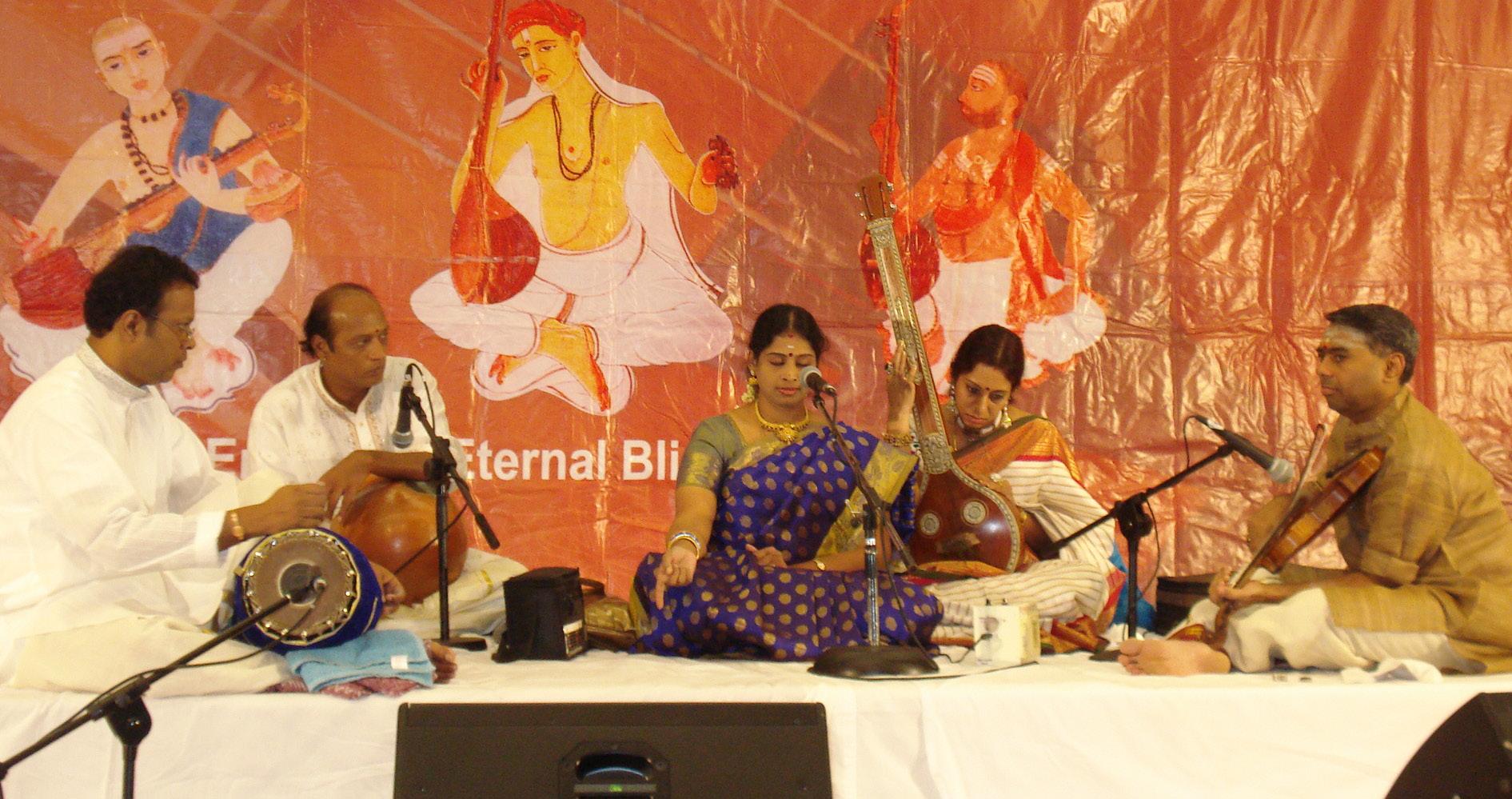
5 minute read
Laya’s annual fest
from 2010-06 Sydney (2)
by Indian Link
up to the mega events of Chennai and Cleveland
feelings) in all their renderings. They commenced with a varnam in raga begada and followed it with krithis in ragas nagaswaravali, janaranjani, ritigowla and behaag. Their in-depth expositions were in nagaswaravali, ramapriya and kamboji, all of which gave ample evidence of their wide repertoire. Their creative singing of alapana, manodharma swaras and neravals was impressive. Accompanists Embar Kannan on the violin, Mannargudi Easwaran on Mridangam and SV Ramani on the ghatam were extremely competent. This was one of the concerts that stood out for its sheer classical pleasure.
Nithyasree Mahadevan Nithyashree has attained name and fame at a young age, not merely because she is the grand daughter of the legendary Palghat Mani Iyer and DK Pattammal and the niece of DK Jayaraman, but she has developed a style of her own and is a huge draw amongst Carnatic music lovers. Nithyashree has shown excellent ability to sing light music also. She prides herself on her devotion to her family and her young children, besides practising hours and hours of music. She started with a varnam in raga surutti and followed it with krithis in raga vagadeeswari, vakulabharanam, ataana, bilahari and chintamani. Her range and high sruti were fully explored in the krithi Sree raja gopala in raga saveri. She was repeatedly applauded for her ragam, thanam, pallavi in raga shanmukhapriya. Despite her concert being the last of the four performances for the day, she held the audience to rapt attention throughout – a great credit to a young artiste.
Isai Sangamam (Confluence of melody) Day three of the festival started with students’ performances and was followed by this event - an item compered and coordinated by Subhasree Thanikasalam with a supporting crew of KN Sasikiran, Chitraveena Ganesh, Anand Dikshit, SV Ramani on mridangam and Kishen Jayendran on tabla. This was an exercise in demonstrating the classical ragas to creating film songs and light music of famous music director Ilayaraja. The resultant fusion music that was created was very enjoyable. Subhasree’s terrific sense of humour and her involvement of the audience towards the end went off extremely well.


Nisha Rajagoplan Here is another young talent who will surely hit big time in the not-too-distant future. Nisha had her initial training from her mother Vasundhara Rajagopal whilst in Toronto, Canada. She has taken up residence in India for nearly 15 years now and has had the privilege of learning from stalwarts like TR Subhramanyam, Calcutta Krishnamurthi and PS Narayanaswamy. She showed touches of her brilliance in the krithi Ninne nera nammi naanura in raga panthuvarali. She also gave the audience a taste of her outstanding talent in the krithi Thiruvadi sharanam in raga kamboji. Her rendering of Sree raja matangi in suddha dhanyasi earlier and Kandena govindana in chandrakauns were melodious. Nisha probably had adequate support on the violin from Dr. Ashok Malur and on the mridangam from Trivandrum Balaji, but one could not help feeling that she deserved better.
Shashank (Flute) A child prodigy of yester year, Shashank was the youngest to perform at the Music Academy, Chennai at the age of 12. He has since received tutelage from KV Narayanaswamy and RK Srikantan and is considered to be one of the foremost players of bamboo flute. He has definitely made a mark on the global stage and the accolades he receives are frequent and many. He started with a varnam Viri boni in bhairavi and followed with Evaroora ninnuveena in raga mohanam where his speed of rendition was achieved without compromising the nuances of the raga. He also played Kamalaptha koola in brindavana saranga, and Mokshamu galadha in saramati. He was often tempted to break into fast to very fast tempo which is probably a feature of his playing for western audiences. His ragam, thanam pallavi in raga kalyani was an exhibition of switching from lower to higher octaves using the magic of his fingers on the flute, and it was delightful for the audience. He also played a ragamalika in bageshwari, bindu malini pantuvarali and kaapi, and followed these with Krishna nee begane in raga yamuna kalyani. He appeared to test his accompanists for their ability to match his speed, but it appeared to sacrifice the classicality of his music. Sudha Raghunathan Already a household name, Padmashri Sudha Raghunathan has established herself as the foremost successor to the legendary ML Vasanthakumari. She dedicated this concert to her guru, whose 80th birth anniversary is being celebrated in 2010. She also dedicated the concert to her grandguru Sree GN Balasubramaniam whose centenary is being celebrated in 2010. She paid her homage to her gurus by singing their compositions. It was a memorable concert for another reason – Sudha’s guru and violinist Embar Kannan’s guru (MLV and Kanyakumari) had associations as a team for over 20 years and this was a forum where the two shishyas had combined together. She started with a varnam in raga ranjani. This was followed by krithis
Sydney Festival has recently attracted attention and it has become a sought after event – the top notch artistes are now vying with each other to get a prestige concert due to the response of the diaspora in Australia and New Zealand in ragas karaharapriya, bhairavam and ritigowla. Her main ragas were suddha saveri (dharinee telusu kondi) and chhaya ranjani, a raga created by GNB, Nee vadinche yendu Sudha’s mastery of the nuances was unquestionable and her creativity has little parallel. She follows the true traditions of her gurus in her gamakas and bhrigas, a benchmark created by GNB. T.M. Krishna Well known as a disciple of Semmangudi Srinivasa Iyer, Krishna started singing to huge audiences at the age of 12 and is now a participant in every music festival, globally. His music attains heights in creativity, fluency and resonance which can only be the mark of a genius. His devotion is evident in some of the krithis he sings, as they ooze bhakthi bhava. In this concert his rendering of Visweswara darshan kar in raga sindhu bhairavi was one such instance. He creates his own variations in the concerts and on this occasion the audience was bewildered by his singing the bhairavi varnam in the middle of his performance rather than at the beginning. It must, however, be said that the viri bon” sung by him was uniquely appealing to everyone. TM Krishna’s music offers another bonus to the listeners/viewers – he gestures with his hands and gives out body language to the point of providing an extra dimension to his music – it may not delight the purists but this artistic eccentricity is sometimes the mark of a genius.
Krishna also sang Akshaya linga vibho in raga sankarabharanam, Raamani samaana evaru in karaharapriya, Kaalai thookki ninraadum deivam in yadukula kamboji and Sarasa saamadana in kaapi narayani. The accompanists were RK Shriram Kumar on the violin, Trichy Sankaran on the mridangam and SV Ramani on the ghatam. Trichy Sankaran’s thani aavarthanam rates a special mention as he played very elaborate notes and matched the brilliance of TM Krishna’s bhairavi in every way.
This festival was notable for the impact created by Embar Kannan and RK Shriram Kumar by their violin accompaniment, but Trichy Sankaran, K. Murugabhoopathi and Mannargudi Easwaran gave a delightful performance on the percussion and Muthukumarasamy equally on the thavil.
In its totality, the festival can be summarized as “scintillating”, with Sydney audiences yearning for more.









